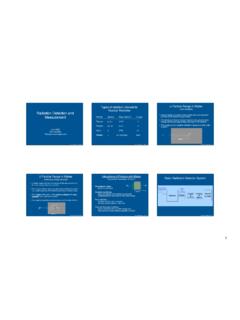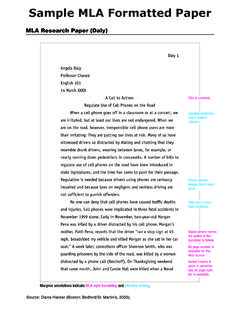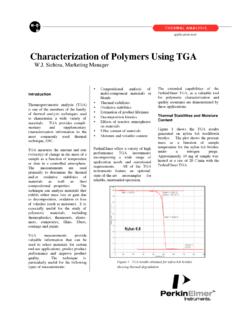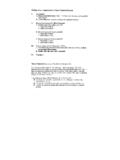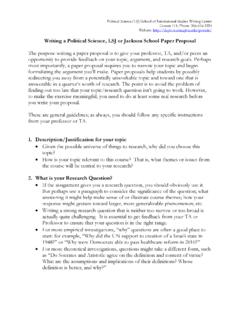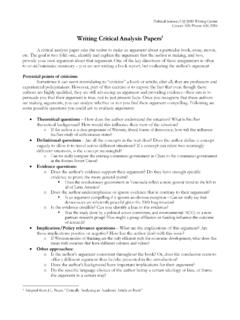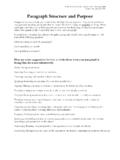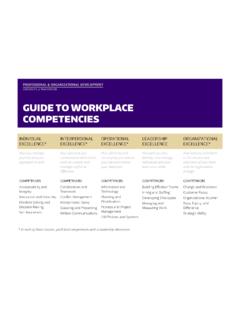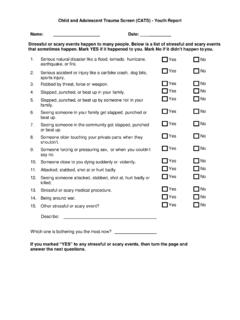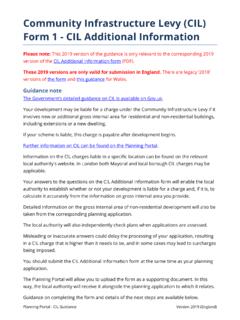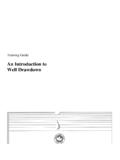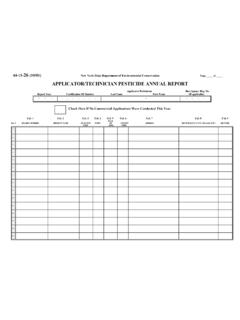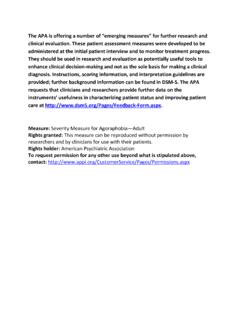Transcription of Strengths and Difficulties Questionnaire (SDQ)
1 Strengths and Difficulties Questionnaire (SDQ). Extensive support materials are available on the SDQ developers website, including copies of the various versions of the instrument, back ground information and scoring instructions. See There are six versions (parent-report and youth-self report) currently specified for NOCC reporting with an additional four versions (teacher-report) that may be of use at the clinical level (see appendices). The 1 versions are administered on admission and are rated on the basis of the proceeding 6. months. The 2 follow up versions are administered on review and discharge and are rated on the basis of the previous 1 month period. The versions specified for NOCC reporting are: PC1 Parent Report measure for Children aged 04-10, Baseline version;. PC2 Parent Report measure for Children and Adolescents aged 4-10, Follow up version;. PY1 Parent Report measure for Youth aged 11-17, Baseline version.
2 PY2 Parent Report measure for Youth aged 11-17; Follow up version;. YR1 Youth self report measure (11-17), Baseline version; and YR2 Youth self report measure (11-17), Follow up version. Please note that the item numbering in the SDQ versions is deliberately non sequential because it covers all items in all versions, both to indicate item equivalence across versions and to assist data entry, especially of translated versions. The table below indicates the items that are included in each version, the rating periods used and the broad content covered by each item. Informant Parent Young Person Age range 4-10 11-17 11-17. Application Baseline Followup Baseline Follow-up Baseline Followup Rating period 6 months 1 month 6 months 1 month 6 months 1 month Item Content Version Items PC1 PC2 PY1 PY2 YR1 YR2. 1-25 Symptoms . 26 Overall . 27 Duration x x . 28-33 Impact . 34-35 Follow up progress x x x.
3 36-38 Cross-Informant information x x x x 39-42 Cross-Informant information x x x x x In addition to the measures listed above, the SDQ has four teacher versions, not specified for NOCC reporting, but which have considerable clinical utility in the assessment and treatment of children and adolescents. These are similar to the Parent-report versions, but do not contain cross-informant items. These measures are included here for information only: TC1 Teacher Report measure for Children aged 04-10 on initial contact with service (Admission);. TC2 - Teacher Report measure for Children and Adolescents aged 04-10 on follow up contact with service (Review & Discharge);. TY1 - Teacher Report measure for Youth aged 11-17 on initial contact with service (Admission); and TY2 - Teacher Report measure for Youth aged 11-17 on follow up contact with service (Review & Discharge). SOURCE: Mental Health National Outcomes and Casemix Collection: Overview of Clinician-Rated and Consumer Self-Report Measures , Mental Health & Suicide Prevention Branch, Department of Health and Ageing 1.
4 Please used gummed label if available Patient or Client Identifier: Area Logo |___|___|___|___|___|___|___|___|. Surname: PC1 Other names: Parent Report Measures for Children and Adolescents Date of Birth: Sex: SDQ(P)04-10 ___ ___ / ___ ___ / ___ ___ ___ ___ Male 1 Female 2. Facility Name: _____ Address: Code: |___|___|___|___|. Instructions: For each item, please mark the box for Not True, Somewhat True or Certainly True. It would help us if you answered all items as best you can even if you are not absolutely certain. Please give your answers on the basis of your child s behaviour over the last six months. Strengths and Difficulties Questionnaire Not True Somewhat Certainly True True 1. Considerate of other people s feelings . 2. Restless, overactive, cannot stay still for long . 3. Often complains of headaches, stomach-aches or sickness . 4. Shares readily with other children, for example toys, treats, pencils.
5 5. Often loses temper . 6. Rather solitary, prefers to play alone . 7. Generally well behaved, usually does what adults request . 8. Many worries or often seems worried . 9. Helpful if someone is hurt, upset or feeling ill . 10. Constantly fidgeting or squirming . 11. Has at least one good friend . 12. Often fights with other children or bullies them . 13. Often unhappy, depressed or tearful . 14. Generally liked by other children . SDQ (P) 04-10 SELF REPORT measure (1 of 2). 15. Easily distracted, concentration wanders . 16. Nervous or clingy in new situations, easily loses confidence . 17. Kind to younger children . 18. Often lies or cheats . 19. Picked on or bullied by other children . 20. Often volunteers to help others (parents, teachers, other children) . 21. Thinks things out before acting . 22. Steals from home, school or elsewhere . 23. Gets along better with adults than with other children.
6 24. Many fears, easily scared . 25. Good attention span, sees chores or homework through to the end . SOURCE: Mental Health National Outcomes and Casemix Collection: Overview of Clinician-Rated and Consumer Self-Report Measures , Mental Health & Suicide Prevention Branch, Department of Health and Ageing 2. Please turn over there are a few more questions on the other side Do you have any other comments or concerns? Over the last six months, have your child s teachers complained of: No A Little A Lot 36. Fidgetiness, restlessness or overactivity . 37. Poor concentration or being easily distracted . 38. Acting without thinking, frequently butting in, or not waiting for his or . her turn No Yes Yes Yes . minor definite severe Difficulties Difficulties Difficulties 26 Overall, do you think that your child has Difficulties in any of the following areas: emotions, concentration, behaviour.
7 Or being able to get along with other people? If you have answered Yes , please answer the following questions about these Difficulties : Less than 6-12 Over a 1-5 months a month months year 27 How long have these Difficulties been present? . A medium A great Not at all A little amount deal 28 Do the Difficulties upset or distress your child? . Do the Difficulties interfere with your child s everyday life in the following areas? 29. HOME LIFE.. SDQ (P) 04-10 SELF REPORT measure (2of 2). 30. FRIENDSHIPS . 31. CLASSROOM LEARNING . 32. LEISURE ACTIVITIES . 33 Do the Difficulties put a burden on you or the family as a . whole? Signature_____ Date_____. Mother/Father/Other (please specify):_____. Module PC1 v2. Thank you very much for your help. Robert Goodman 2002. SOURCE: Mental Health National Outcomes and Casemix Collection: Overview of Clinician-Rated and Consumer Self-Report Measures , Mental Health & Suicide Prevention Branch, Department of Health and Ageing 3.
8 Please used gummed label if Patient or Client Identifier: Area Logo available |___|___|___|___|___|___|___|___|. Surname: PC2. Parent Report Measures for Other names: Children and Adolescents Date of Birth: Sex: SDQ(P)04-10 FU. ___ ___ / ___ ___ / ___ ___ ___ ___ Male 1 Female 2. Facility Name: _____. Address: Code: |___|___|___|___|. Instructions: For each item, please mark the box for Not True, Somewhat True or Certainly True. It would help us if you answered all items as best you can even if you are not absolutely certain. Please give your answers on the basis of your child s behaviour over the last month. Strengths and Difficulties Questionnaire Not True Somewhat Certainly True True 1. Considerate of other people s feelings . 2. Restless, overactive, cannot stay still for long . 3. Often complains of headaches, stomach-aches, or sickness . 4. Shares readily with other children, for example toys, treats, pencils.
9 5. Often loses temper . 6. Rather solitary, prefers to play alone . 7. Generally well behaved, usually does what adults request . 8. Many worries or often seems worried . 9. Helpful if someone is hurt, upset or feeling ill . 10. Constantly fidgeting or squirming . 11. Has at least one good friend . 12. Often fights with other children or bullies them . 13. Often unhappy, depressed or tearful . SDQ (P) 04-10 FU SELF REPORT measure (1 of 2). 14. Generally liked by other children . 15. Easily distracted, concentration wanders . 16. Nervous or clingy in new situations, easily loses confidence . 17. Kind to younger children . 18. Often lies or cheats . 19. Picked on or bullied by other children . 20. Often volunteers to help others (parents, teachers, other children) . 21. Thinks things out before acting . 22. Steals from home, school or elsewhere . 23. Gets along better with adults than with other children.
10 24. Many fears, easily scared . 25. Good attention span, sees chores or homework through to the end . Please turn over there are a few more questions on the other side Do you have any other comments or concerns? SOURCE: Mental Health National Outcomes and Casemix Collection: Overview of Clinician-Rated and Consumer Self-Report Measures , Mental Health & Suicide Prevention Branch, Department of Health and Ageing 4. Much A bit worse About the A bit better Much worse same better 34 Since coming to the service, are your child s . problems: A medium Not at all A little A great deal amount 35 Has coming to the service been helpful in other ways providing information or making the problems more . bearable? No Yes Yes Yes . minor definite severe Difficulties Difficulties Difficulties 26 Overall, do you think that your child has Difficulties in any of the following areas: emotions, concentration.
